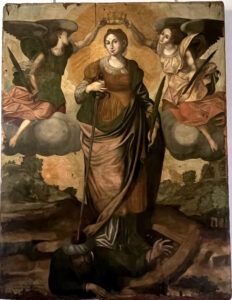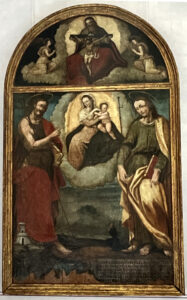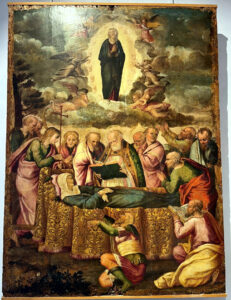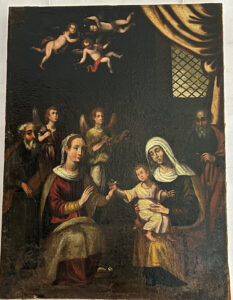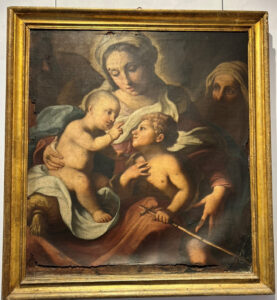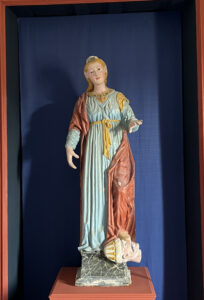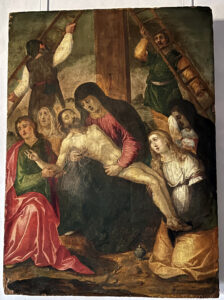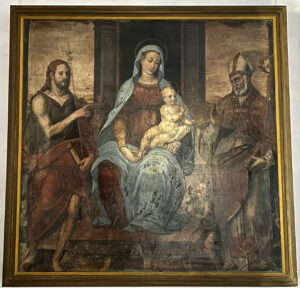Room I
Room I is dedicated to Monsignor Martino D’Acugna, bishop of Lipari from 1585 to 1593, who is credited with the recovery of the relic of the thumb of St. Bartholomew. On display are 16th-century works, mostly painted on wood.
From the terrible experience of the Turkish sack in 1544, Lipari emerged more vigorous and full of ferment. On an artistic level, despite the irreparable losses linked to the destruction by the pirate Barbarossa, some interesting evidence reappeared thanks to the exchanges and trade that the people of Lipari entertained with the numerous centres of the Peninsula.
The works that have survived, due to their quality and artistic connotations, reflect the taste of the patrons, made up of prelates and laymen of various origins and social backgrounds, with a clear preponderance linked to the Neapolitan environment, but also to the Messina and Palermo area.
On the walls, starting from the right, are:
– the Deposition, once on the altar of S. Maria della Pietà in Lipari Cathedral. Balanced and sober, it is reminiscent of the panel of the same subject painted by Giovan Bernardo Lama for the church of San Giacomo degli Spagnoli in Naples.
– the panel painting of the Madonna and Child between Saints John the Baptist and Nicolò (1565), to be attributed to the Neapolitan painter Decio Tramontano, originally placed on the high altar of the Church of Maria SS. dell’Arco and Saints John the Baptist and Nicolò, within the walls of Lipari Castle. The panel, in which the acquisitions of Renaissance painting can be seen, bears an interesting inscription at the bottom informing about the commission, date and place of execution.
– the panel painting of Saint Catherine of Alexandria, by the painter Giovanni Filippo de Floris, which can be traced back to the small church of the same name, no longer extant, which stood near the present cemetery on Lipari. The chapel, which was reopened for worship during the second half of the 16th century, but already existed before the ‘ruin’, bears witness to the spread of the cult of the Alexandrian martyr also on Lipari, as attested, among other things, by the presence of a Confraternity of the same name, whose deed of incorporation is preserved. This Confraternity had obtained the possibility of keeping the statue of the Saint (present in the centre of the same room, although lacking the iconographic elements that distinguish it) in the Church of the Conception at the Castle of Lipari.
– the ribbed panel depicting The Madonna and Child between Saints John the Baptist and James, offered as a votive gift for a survivor of a shipwreck by Giacomo Galluppi, owner of a ship almost certainly used for trade; the work also documents, through the inscription, the lands reached by Lipari sailors.
– the Dormitio Virginis, attributable to Giovan Filippo Criscuolo (1495-1584) and workshop, from Lipari Cathedral, where the presence of an altar dedicated to the Assumption of the Virgin is documented as early as the first pastoral visit after the ‘ruin’. The artistic composition, in which the Virgin in glory among angels is depicted in the upper register, is inspired by apocryphal narratives: this is demonstrated by the presence of the Jew, whose hands dried up in an attempt to overturn the Virgin Mary’s bier, and that of the apostles in prayer who, at the moment of the Virgin’s death, found themselves miraculously gathered in Jerusalem.
– the Holy Family with St. Anne and St. Joachim, probably made locally, comes from the Church of Our Lady of Graces in Castello; it cannot be ruled out that it was already in the earlier, more modest church, in which an altar dedicated to St. Anne was found in 1681. Despite its expressive mediocrity, it contains interesting details.
– The Madonna and Child with St. John, possibly from the 17th century, takes up a recurring 16th century scheme in its iconography in the early 19th century.


